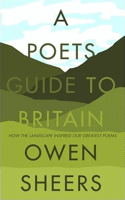This time last year I wrote about the BBC's poetry season, contrasting a documentary on Gawain and the Green Knight by Simon Armitage with the excellent Owen Sheers' series, ‘A Poet’s Guide to Britain’. Since then, the two writers have edited anthologies of nature poetry - Sheers with one based on his series, Armitage with The Poetry of Birds. The Armitage is a joint effort with bird-watching author Tim Dee, who provides fascinating descriptions of the birds at the end of the book. This approach contrasts with Sheers' - he provides minimal editorial material, letting the poems speak for themselves and saying nothing about the landscapes or the authors (the poems are not even dated so the uninitiated will have no idea whether they are reading something recent unless they investigate the copyright information at the back or google the name of the writer). It's a bit if a shame because the television programmes were full of fascinating material; I have some sympathy for the Amazon reviewer who "was looking forward to a 'book of the series'. There are some beautiful poems in this book but it's not what I was expecting so I'm disappointed with my purchase."
Having said this, I enjoyed Owen Sheers' selections and the way he strings poems in each section together, like a renga sequence or a carefully constructed compilation tape, where each 'speaks to the next and, in some way, listens to the one before.' So, for example, the last part, 'Coast and Sea', begins with 'Dover Beach', then moves to another Victorian vision of the moonlit sea, Browning's 'Meeting at Night'. This introduces the theme of lovers which continues in Hardy's 'Beeny Cliff' and from there it's an easy segue into another Hardy, 'To a Sea-Cliff (Durleston Head)'. The cliff theme continues with Charlotte Smith's 'Beachy Head', Shakespeare's 'King Lear, Act 4, Scene 6', and Anne Ridler's 'Bempton Cliffs'. So it goes on, taking in poems by Hopkins, Keats and Edward Thomas along with contemporaries like Carol Rumens, Daljit Nagra and Menna Elfyn. He also includes a second poem by Anne Ridler, this time describing the sea at Zennor in Cornwall (I mention this because I was on this sea, in a boat heading to Seal Island near Zennor, only last week).
I'll end this post by reproducing one of these poems of Coast and Sea: Robert Browning's 'Meeting at Night' (1845)
I.
The grey sea and the long black land;
And the yellow half-moon large and low;
And the startled little waves that leap
In fiery ringlets from their sleep,
As I gain the cove with pushing prow,
And quench its speed i' the slushy sand.
II.
Then a mile of warm sea-scented beach;
Three fields to cross till a farm appears;
A tap at the pane, the quick sharp scratch
And blue spurt of a lighted match,
And a voice less loud, thro' its joys and fears,
Than the two hearts beating each to each!

Sounds great.
ReplyDeleteWhenever I lecture on the subject called Life and Times of Famous Literary Figures, I am always desperate for background material. Certainly it is easy to find the books, essays and poems of Hopkins, Keats, Tennyson, Austen, the Brontes, Byron etc.
But I want where they studied and worked, what homes they lived in, the landscapes that provided their raw material etc etc
Thanks.
ReplyDeleteA recent anthology that does provide useful and engaging background material on each poet is Neil Astley's Earth Shattering. I like this approach myself but I can see why anthologists are reluctant to put lots of their own comments into these books.
I should also mention that a DVD of Owen Sheers' TV programmes is due out this month, according to his website.